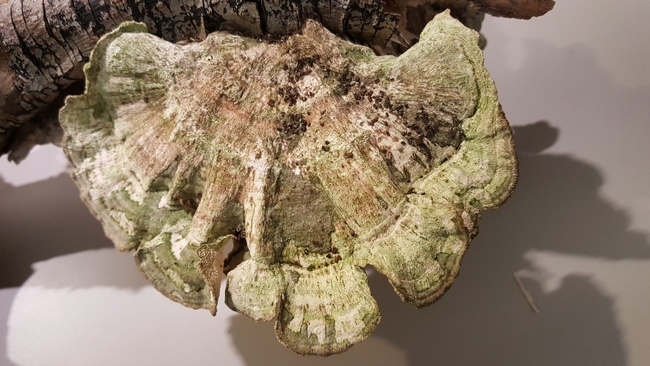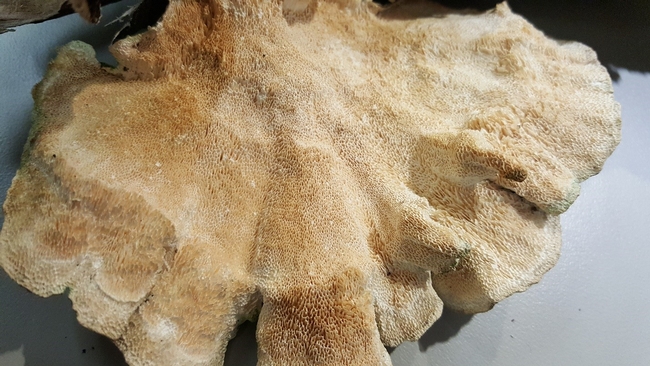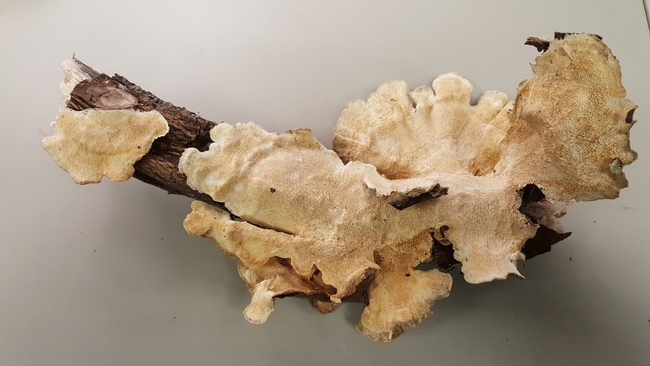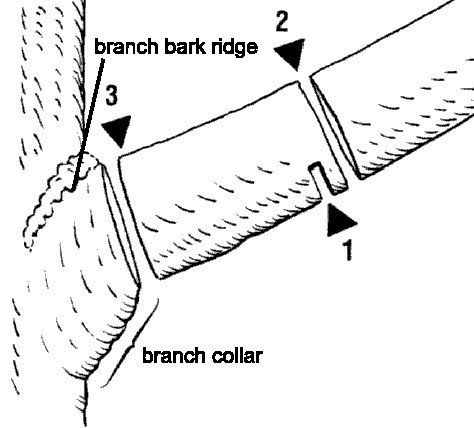Field Finds: Fungus Among Us
Siomara Zendejas, Ventura County UCCE SRA
I stumbled upon this delightful find while doing some field work in an avocado orchard. The light coming in through the canopy made it very easy to spot the branch among the leaf litter. It seemed to be a sort of shelf fungus that either settled in after the branch fell, or was itself the cause for the branch falling. I thought the decorated portion of branch would be harder to break off, but it was surprisingly easy because the wood inside was all soft and spongy, probably due to white rot. Even with all the rain we had this spring, it was still a surprise to find this treasure! Especially considering it was already dry by the time I found it.
Our own Dr. Jim Downer mentioned it could possibly be a member of the Trametes genus, which has a widespread distribution and contains roughly 50 species.The mushroom could potentially be Trametes hirsuta (hairy bracket), or Trametes versicolor (the famous turkey tail fungus). Both fungi can cause white rot and appear green due to tiny algae growing on their top surface. There are also two other look-alike fungi: Stereum ostrea (the false turkey-tail) and Trametes betulina (multicolor gill polypore). However, Stereum ostrea has no pores underneath and Trametes betulina has gills; my mushroom has many pores in its underside!
Fig 1. The top of the mushroom cap with green algae coloring it
Fig 2. Pores on bottom side of fungus
Fig 3. Underside of fungus distributed along dead branch
White rot, for those fortunate enough to have never found it in their trees, is a fungal disease that eats away at both the lignin and the cellulose of a tree. Both of these are very important compounds that give trees their strength and structure. The rot leaves the inner wood feeling spongy and soft, and appears pale or white. The danger of this rot, besides the potential death of the tree, is that infected branches or whole trees can fall despite looking healthy on the outside. The UCANR website has wonderful resources on how to identify and manage different kinds of rots that I'll include here: https://ipm.ucanr.edu/PMG/PESTNOTES/pn74109.html A common result of poor pruning practice, or due to branch damage, is a residual stub that can easily be infected by these fungi. Prompt attention to this damaged wood can prevent infection along with good proper pruning, as indicated in the diagram below.
Remove a branch by making the pruning cut just outside the branch bark ridge and branch collar, as indicated by number 3. When removing a limb larger than about 2 inches in diameter, make three cuts in the order indicated. Make the first cut from below, about one-fourth of the way through the limb and 1 or 2 feet from the trunk. Make the second cut about 2 inches beyond the first cut, cutting from above until the limb drops. Make the final cut at number 3.
It may be worth it to keep a look out for any mushroom laden branches or suspicious stubs, because the can signal a deeper problem underneath the surface. We had a wet spring this year and many a mushroom flourished during that time! For now, this mushroom will be sitting on my desk as both a lovely decoration and a reminder to keep my eyes peeled for the next field find.



